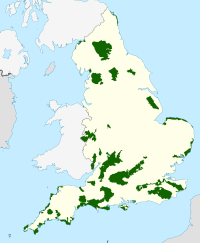Forest of Bowland
Template:Geobox Protected Area
The Forest of Bowland, also known as the Bowland Fells, is an area of barren gritstone fells, deep valleys and peat moorland, mostly in north-east Lancashire, England. A small part lies in North Yorkshire, and much of the area was historically part of the West Riding of Yorkshire. It has been designated an Area of Outstanding Natural Beauty (AONB) since 1964, and is used for grouse shooting, walking and cycling, though it is relatively unfrequented by tourists. One of the best known features of the area is Pendle Hill, which is separated from the main part of the Forest of Bowland AONB by the Ribble Valley.
13% of the AONB is designated a Site of Special Scientific Interest for its important areas of heather moorland and blanket bog. The area is nationally and internationally important for its upland bird populations – the hen harrier is the symbol of the AONB. There are over 500 listed buildings and 18 scheduled monuments within the AONB.
The name 'forest' is used in its traditional sense of 'a royal hunting ground', and much of the land still belongs to the British Crown as part of the Duchy of Lancaster. In the past wild boar, deer, wolves, wild cats and game roamed the forest.

Bowland remains as the northwestern remainder of the ancient wilderness that once stretched over a huge part of England, encompassing the Forest of Bowland, Sherwood Forest (Nottinghamshire), the New Forest (Hampshire) and Savernake Forest (Wiltshire). While the Trough of Bowland (the valley and high pass connecting the Wyre (at Marshaw) and Langden Brook and dividing the upland core of Bowland into two main blocks) represents the area, to many, on account of its popularity, it is in fact only a small part of the wider Forest of Bowland area.
The hills on the western side of the Forest of Bowland attract walkers from Lancaster and the surrounding area. Overlooking Lancaster is Clougha Pike, the western-most hill. The hills form a large horseshoe shape with its open end facing west. Clockwise from Lancaster the hills are Clougha Pike (413 m), Grit Fell (468 m), Ward's Stone (561 m), Wolfhole Crag (527 m), White Hill (544 m), Whins Brow (476 m), Totridge (496 m), Parlick (432 m), Fair Snape Fell (510 m), Bleasdale Moor (429 m), and Hawthornthwaite fell (478 m).
The area is home to the geographic centre of Great Britain which is close to the Whitendale Hanging Stones, around 4 miles north of Dunsop Bridge.
The Forest of Bowland is home to an annual challenge event: The Bowland Challenge where teams of walkers navigate around a series of grid references over a ten hour period. Proceeds of the event go to support Bowland Pennine Mountain Rescue Team.
In 2007, the Bowland Challenge was held on June 29 and 30.
The third annual Bowland Challengewill be held on July 11th & 12th 2008.

External links
- Forest of Bowland official site
- visitLancashire.com - Official Lancashire Tourism information, Walks and Cycle Routes in the Forest of Bowland
- Walks and Pubs in the Forest of Bowland
- Photographs of the Forest of Bowland
- Bowland Forest Gliding Club
Further reading
- Walking in the Forest of Bowland and Pendle, Terry Marsh. Cicerone 2008 ISBN 978 1 85284 515 5

